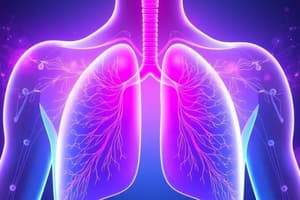Podcast
Questions and Answers
What is the function of Inspiratory Reserve Volume (IRV)?
What is the function of Inspiratory Reserve Volume (IRV)?
- Volume of air that can be inspired beyond the tidal volume (correct)
- Volume of air expired in the first second of a test
- Volume of air that remains in the lungs after maximal expiration
- Volume of air forcefully expired after a deep breath in
Which lung volume is an indicator of obstructed airways?
Which lung volume is an indicator of obstructed airways?
- Residual volume
- Expiratory Reserve Volume (ERV)
- Tidal volume
- Forced Expiratory Volume in 1 second (FEV1 sec) (correct)
What does Residual Volume (RV) refer to?
What does Residual Volume (RV) refer to?
- Volume of air that can be forcefully expired after a deep breath in
- Volume of air inspired beyond the tidal volume
- Volume of air expired in the first second of a test
- Volume of air remaining in the lungs after maximal expiration (correct)
Which respiratory capacity decreases in restrictive lung disorders?
Which respiratory capacity decreases in restrictive lung disorders?
What is the function of Expiratory Reserve Volume (ERV)?
What is the function of Expiratory Reserve Volume (ERV)?
Which lung volume represents the total amount of exchangeable air in the lungs?
Which lung volume represents the total amount of exchangeable air in the lungs?
Inspiratory Capacity (IC) is defined as:
Inspiratory Capacity (IC) is defined as:
Which lung capacity is NOT directly measured using a spirometer?
Which lung capacity is NOT directly measured using a spirometer?
Flashcards
Inspiratory Reserve Volume (IRV)
Inspiratory Reserve Volume (IRV)
The amount of air you can forcefully inhale after a normal breath.
Expiratory Reserve Volume (ERV)
Expiratory Reserve Volume (ERV)
The amount of air you can forcefully exhale after a normal breath out.
Residual Volume (RV)
Residual Volume (RV)
The amount of air that stays in your lungs even after you exhale as much as possible.
Tidal Volume (TV)
Tidal Volume (TV)
Signup and view all the flashcards
Inspiratory Capacity (IC)
Inspiratory Capacity (IC)
Signup and view all the flashcards
Functional Residual Capacity (FRC)
Functional Residual Capacity (FRC)
Signup and view all the flashcards
Vital Capacity (VC)
Vital Capacity (VC)
Signup and view all the flashcards
Total Lung Capacity (TLC)
Total Lung Capacity (TLC)
Signup and view all the flashcards
Study Notes
Lung Volumes
- Inspiratory reserve volume: 3000 mL (amount of air that can be inspired forcefully after inspiration of the tidal volume)
- Expiratory reserve volume: 1100 mL (amount of air that can be forcefully expired after expiration of the tidal volume)
- Residual volume: 1200 mL (volume of air still remaining in respiratory passages and lungs after most forceful expiration)
Respiratory Capacities
- Inspiratory capacity: tidal volume + inspiratory reserve volume (amount of air a person can inspire maximally after normal expiration)
- Functional residual capacity: expiratory reserve volume + residual volume (amount of air remaining in the lungs at the end of normal expiration)
- Vital capacity: inspiratory reserve volume + tidal volume + expiratory reserve volume (maximum volume of air that can be expelled from the respiratory tract after maximum inspiration)
- Total lung capacity: inspiratory reserve volume + expiratory reserve volume + tidal volume + residual volume
Respiratory Rate and Ventilation
- Respiratory rate: number of breaths taken per minute
- Minute ventilation: total amount of air moved into and out of the respiratory system each minute (tidal volume x respiratory rate)
Anatomic Dead Space and Alveolar Ventilation
- Anatomic dead space: space formed by nasal cavity, pharynx, larynx, trachea, bronchi, bronchioles, and terminal bronchioles
- Alveolar ventilation: volume of air available for gas exchange per minute
Forced Vital Capacity and Forced Expiratory Volume
- Forced vital capacity (FVC): maximal volume of air that can be forcefully expired as fast as possible after a deep breath in
- Forced expiratory volume in 1 second (FEV1 sec): volume of air expired in the first second of the test
- Forced expiratory volume 1% (FEV1%): FEV1sec expressed as a percentage of the FVC
Lung Function and Diseases
- Lung function tests can diagnose and monitor diseases of the lungs, e.g., asthma, chronic obstructive pulmonary diseases
Dynamic and Static Lung Volumes
- Dynamic lung volume: measured in relation to time, dependent on rate of flow of air, usually determined during repetitive breathing
- Static lung volume: independent of rate of air flow, usually determined during one maximal inspiration and/or expiration
Measurement of Lung Volumes and Capacities
- Measured using spirometer or vitalograph
- Comparing measurements to "normal ranges" can diagnose and track disease progress, e.g., asthma, COPD
- Influenced by gender, age, body size, and physical fitness
Studying That Suits You
Use AI to generate personalized quizzes and flashcards to suit your learning preferences.




